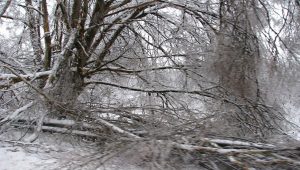
In the past few weeks, the southeastern corner of our nation has suffered from two major hurricanes. Through news reporting, we watched Hurricane Florence approach the Carolinas for what seemed like a week. Clean-up from that September storm was still underway when Michael slammed into the Florida panhandle as a category 4 hurricane, then roared across Georgia to dump more rain on our northeastern neighbors. Recovery measures are underway, but these storms cost many families dearly through loss of life, homes, businesses, farms, crops, livestock, and pets.
Recovery is the last step in emergency management. All of the other steps are preparatory actions that can help us survive emergencies and disasters that we may – or may not – see coming. Emergency preparedness starts with:
- Risk assessment. We need to take some time to consider the environments that surround us – home, work, car, et cetera – and all risk factors associated with them.
- Risk mitigation. Once we identify a risk, we need to make necessary changes to eliminate the hazard if possible, or take steps to mitigate damage if the risk factor is something we can’t completely control.
- Prepare. Emergencies often require a quick response, both mentally and physically. We can prepare for emergency survival based on our risk assessment. If evacuation is likely, we’ll need a grab and go bag for each family member, including pets. On the other hand, if shelter in place is the better option, we need to have appropriate stores of water and food, especially food that can be prepared even if the power is out.
How to prepare for winter storms
During good weather, winterize your home by:
- Insulating walls and attics
- Sealing air leaks around windows and doors with caulk or weather-stripping
- Insulating storm doors and windows.
As you do routine grocery shopping, purchase one or two extra shelf-stable, ready-to-eat canned goods, like non-condensed soup, canned chicken breast and tuna, pasta meals, and vegetables. This builds your emergency food supply without adding too much to your grocery bill each week. Unlike frozen foods, canned foods won’t be damaged by a long power outage. Make sure you have a manual can opener, too. Dry foods like pasta and rice are stable, but they require water and cooking, luxuries that may be in short supply during a storm.
The Federal Emergency Management Agency recommends stocking at least a three-day supply of adequate nutrition, water and prescription medications for each family member, including pets and livestock. Why three days? That’s how long it may take to restore electricity and clear roads of ice, fallen trees and other hazards. But as we’ve seen with recent natural disasters, actual restoration of electricity, water and transportation can take much longer.
To get through disruptive storms or other emergencies you’ll also need:
- Water – one gallon per person per day for drinking and hygiene
- Alternate heat source and fuel, such as firewood for your fireplace
- Flashlights with extra batteries
- NOAA weather radio
- First aid kit
- Entertainment, such as board games, cards and books to keep boredom and cabin fever at bay
What to do if your power goes out
Use foods from the refrigerator first, then frozen foods, then canned foods. If your oven doesn’t work without electricity, use coals in your fireplace to heat food. Use cast iron cookware if you have it, or place food in pockets of aluminum foil. Remember Hobo Packs from summer camp? Alternatively, you can cook outside on your grill. Don’t bring your grill inside; this can cause deadly carbon monoxide to build up in your home. If you must venture outside, bundle up, including gloves and a warm hat that covers your ears.
Go ahead and fill up some containers with water. If there’s space in your freezer, make ice. It will help keep frozen foods frozen longer without power. Fill your bathtub with water for washing and toilet flushing.
To stay warm, centralize the family in one room, preferably one with a fireplace or woodstove, and close the doors to the other rooms. Bring blankets, books, and games to help the time pass.
HOBO PACKS – Add a little more fun to snow days with some fireplace cooking. Pull out whatever meat you have in the refrigerator and dice it into small pieces. Do the same with fresh veggies like potatoes, celery, carrots, onions, mushrooms, and peppers. Small pieces cook more evenly and quickly over the coals. Put each ingredient in separate bowls and offer salt and pepper at the end of the line.
Next, make an aluminum foil pocket for each member of the family: Roll out two 12-inch sheets of aluminum foil (heavy duty is best) and sandwich a moist paper towel between the sheets. The moisture also helps food cook evenly. Let everyone add their choices from the diced food selection to the center of the aluminum foil sandwich. Put the short edges together and roll the foil down several times until you can’t roll anymore. Repeat for each side of the pocket, completely sealing the food into the foil. Have everyone write their initials or name on the foil.
Place the packs on warm coals in the fireplace. Don’t put them into flames. Let them cook for about 20 minutes. Heavily-filled packs may need more cooking time. Use tongs to pull the packs off the coals. You can eat right out of the foil to make clean up easier.